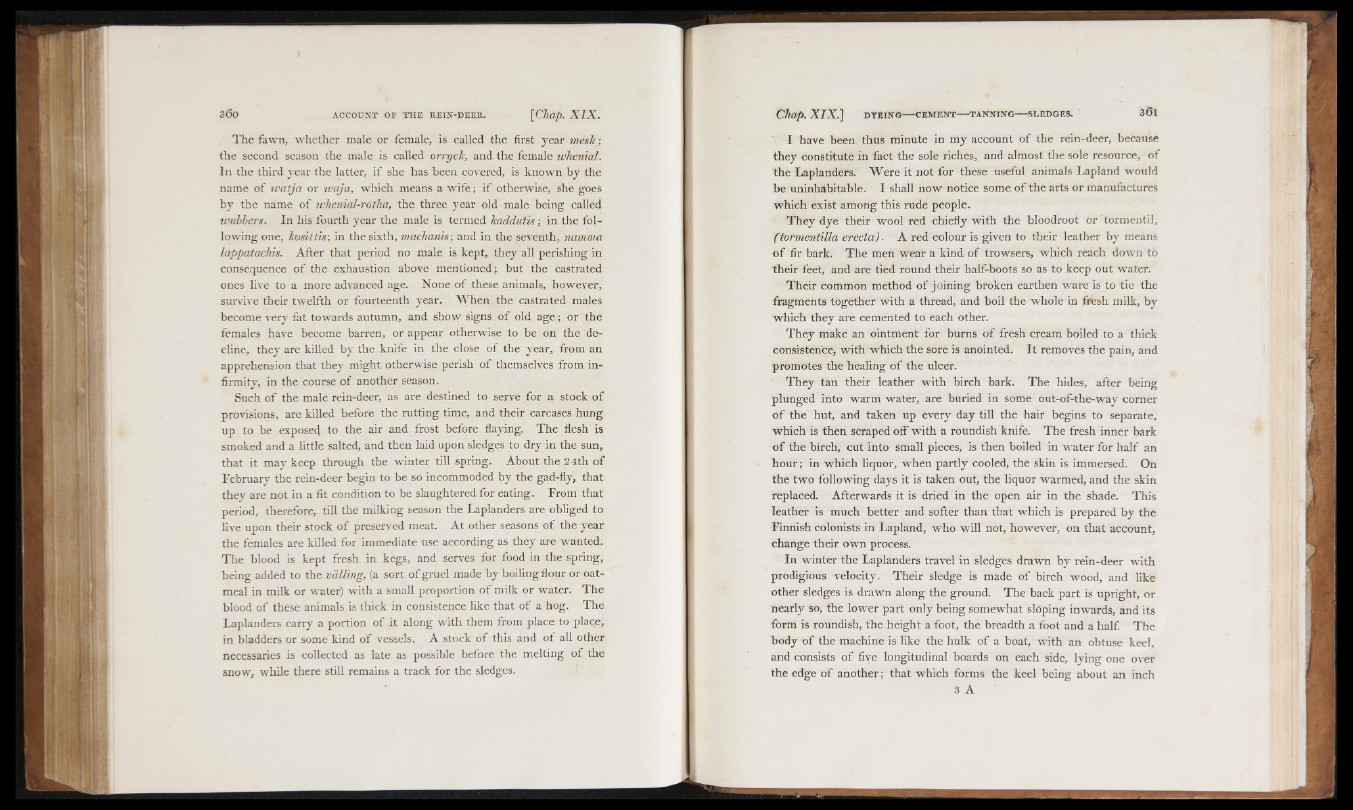
The fawn, whether male or female, is called the first year mesh ',
the second season the male is called orryck, and the female whenial.
In the third year the latter, if she has been covered, is known by the
name of watja or ivaja, which means a w ife ; i f otherwise, she goes
by the name o f whenial-rotha, the three year old male being called
wubbers. In his fourth year the male is termed kaddntis; in the following
one, kosittis; in the sixth, machanis; and in the seventh, namma
lappatachis. After that period no male is kept, they all perishing in
consequence o f the exhaustion above mentioned; but the castrated
ones live to a more advanced age. None of these animals, however,
survive their twelfth or fourteenth year. When the castrated males
become very fat towards autumn, and show signs o f old age; or the
females have become barren, or appear otherwise to be on the decline,
they are killed by the knife in the close o f the year, from an
apprehension that they might otherwise perish of themselves from infirmity,
in the course of another season.
Such o f the male rein-deer, as are destined to serve for a stock of
provisions, are killed before the rutting time, and their carcases hung
up to be expose4 to the air and frost before flaying. The flesh is
smoked and a little salted, and then laid upon sledges to dry in the sun,
that it may keep through the winter till spring. About the 24th of
February the rein-deer begin to be so incommoded by the gad-fly, that
they are not in a fit condition to be slaughtered for eating. From that
period, therefore, till the milking season the Laplanders are obliged to
live upon their stock of preserved meat. At other seasons o f the year
the females are killed for immediate use according as they are wanted.
The blood is kept fresh in kegs, and serves for food in the spring,
being added to the vailing, (a sort of gruel made by boiling flour or oatmeal
in milk or water) with a small proportion o f milk or water. The
blood o f these animals is thick in consistence like that of a hog. The
Laplanders carry a portion of it along with them from place to plaqe,
in bladders or some kind of vessels. A stock of this and of all other
necessaries is collected as late as possible before the melting of the
snow, while there still remains a track for the sledges.
I have been thus minute in my account o f the rein-deer, because
they constitute in fact the sole riches, and almost the sole resource, o f
the Laplanders. Were it not for these useful animals Lapland would
be uninhabitable. I shall now notice some of the arts or manufactures
which exist among this rude people.
They dye their wool red chiefly with the bloodroot or tormentil,
(tormentilla erecta) ■ A red colour is given to their leather by means
o f fir bark. The men wear a kind of trowsers, which reach down to
their feet, and are tied round their half-boots so as to keep out water.
Their common method o f joining broken earthen ware is to tie the
fragments together with a thread, and boil the whole in fresh milk, by
which they are cemented to each other.
They make an ointment for burns of fresh cream boiled to a thick
consistence, with which the sore is anointed. It removes the pain, and
promotes the healing of the ulcer.
They tan their leather with birch bark. The hides, after being
plunged into warm water, are buried in some out-of-the-way corner
o f the hut, and taken up every day till the hair begins to separate,
which is then scraped off with a roundish knife. The fresh inner bark
o f the birch, cut into small pieces, is then boiled in water for half an
hour; in which liquor, when partly cooled, the skin is immersed. On
the two following days it is taken out, the liquor warmed, and the skin
replaced. Afterwards it is dried in the open air in the shade. This
leather is much better and softer than that which is prepared by the
Finnish colonists in Lapland, who will not, however, on that account,
change their own process.
In winter the Laplanders travel in sledges drawn by rein-deer with
prodigious velocity. Their sledge is made of birch wood, and like
other sledges is drawn along the ground. The back part is upright, or
nearly so, the lower part only being somewhat sloping inwards, and its
form is roundish, the height a foot, the breadth a foot and a half. The
body of the machine is like the hulk of a boat, with an obtuse keel,
and consists o f five longitudinal boards on each side, lying one over
the edge of another; that which forms the keel being about an inch
3 A